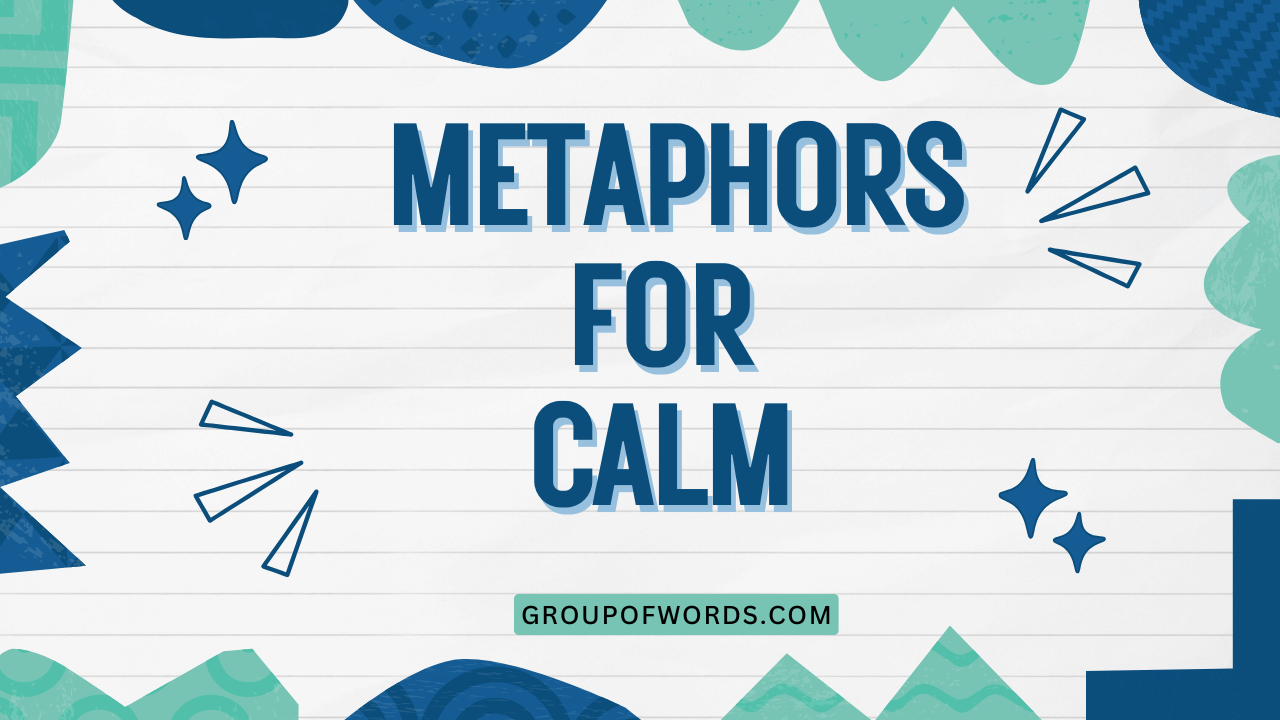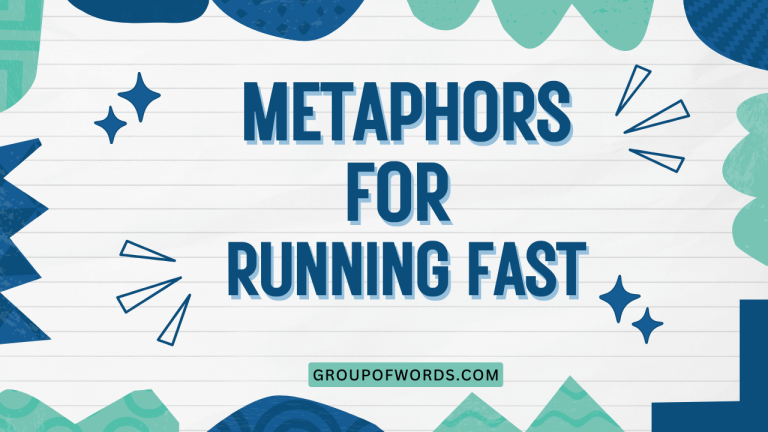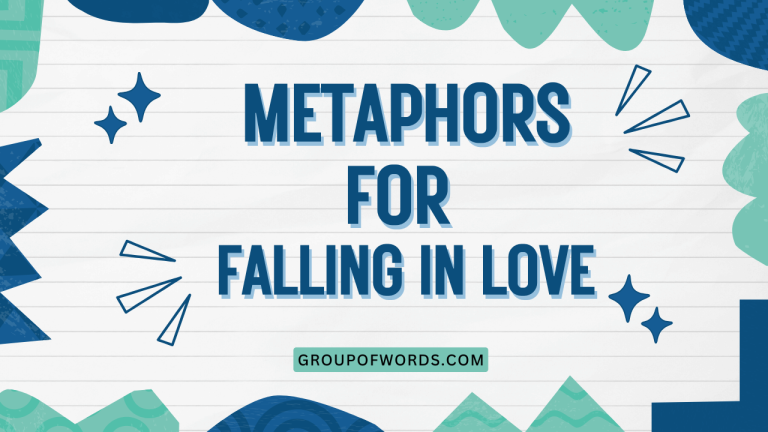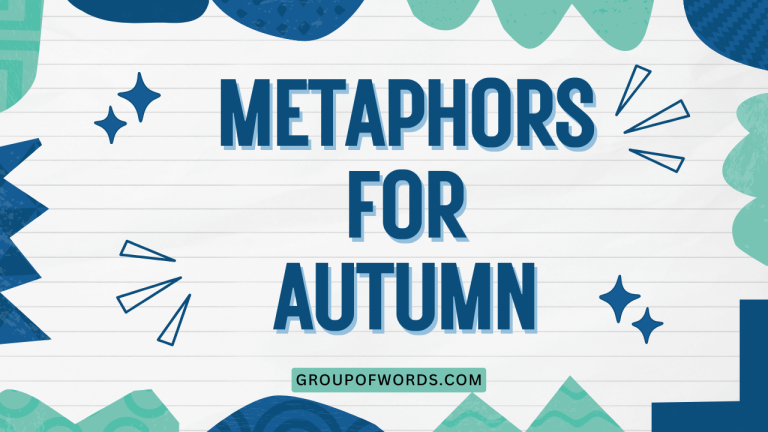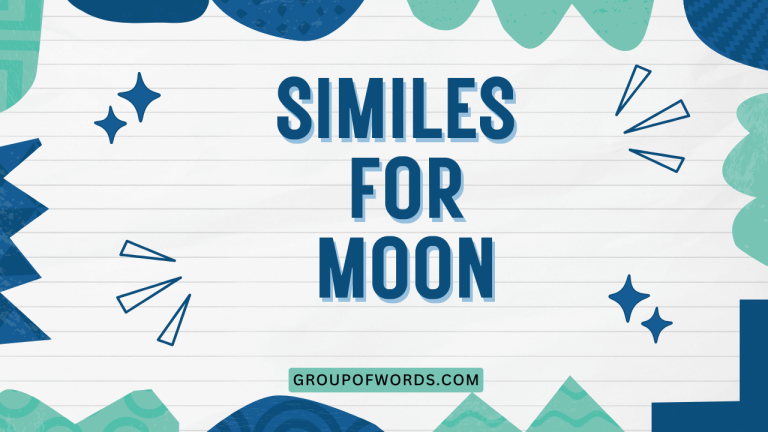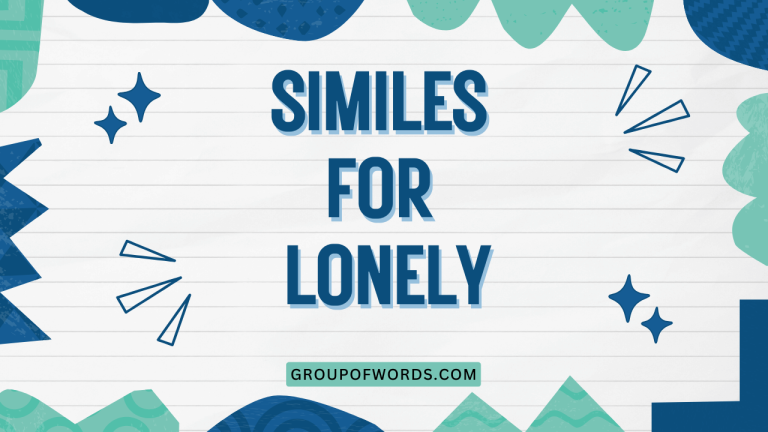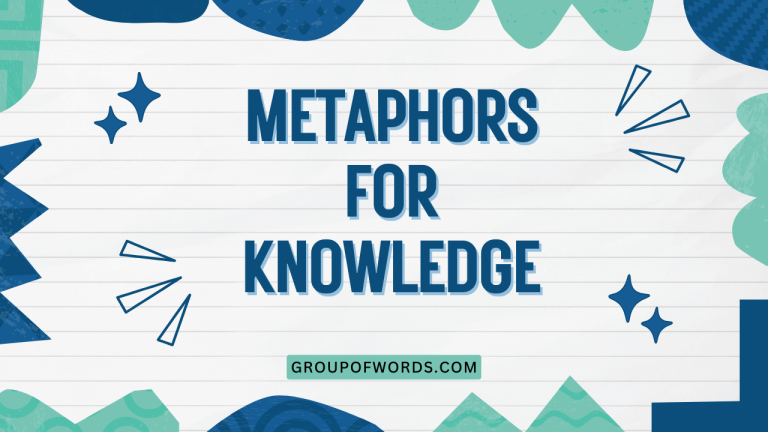Finding Your Inner Peace: Mastering Metaphors for Calm
The English language is rich with figurative expressions that allow us to describe abstract concepts in vivid and relatable ways. When it comes to the feeling of calm, metaphors provide a powerful tool to articulate this state of tranquility.
Understanding and using metaphors for calm not only enhances your descriptive abilities but also allows you to connect with others on a deeper emotional level. This article is designed to provide a comprehensive guide to metaphors for calm, exploring their definition, types, usage rules, and common mistakes.
Whether you’re a student, writer, or simply someone seeking to better express themselves, this guide will equip you with the knowledge and skills to effectively use metaphors for calm.
Table of Contents
- Introduction
- Definition of Metaphors for Calm
- Structural Breakdown
- Types and Categories of Metaphors for Calm
- Examples of Metaphors for Calm
- Usage Rules for Metaphors for Calm
- Common Mistakes with Metaphors for Calm
- Practice Exercises
- Advanced Topics
- Frequently Asked Questions
- Conclusion
Definition of Metaphors for Calm
A metaphor is a figure of speech that directly compares two unrelated things without using “like” or “as.” It asserts that one thing *is* another, creating a vivid and imaginative comparison. Metaphors are used to describe abstract or complex ideas in more concrete and understandable terms.
In the context of “calm,” metaphors are used to evoke the feeling of peace, tranquility, and serenity by comparing it to something else that embodies these qualities.
Metaphors for calm can be classified by the source domain they draw from – nature, water, light, sound, etc. The function of these metaphors is to create a sensory experience for the reader or listener, allowing them to better understand and visualize the feeling of calm.
The contexts in which these metaphors are used are varied, ranging from literature and poetry to everyday conversation and therapeutic settings. By using metaphors, we can move beyond simple descriptions and tap into the emotional resonance of the feeling of calm.
Structural Breakdown
The structure of a metaphor typically involves two key elements: the **tenor** and the **vehicle**. The tenor is the subject being described (in this case, calm), and the vehicle is the object or concept used to represent it.
The connection between the tenor and vehicle is based on shared characteristics or associations.
For example, in the metaphor “Her mind was a tranquil lake,” the tenor is “her mind” (representing calm), and the vehicle is “a tranquil lake.” The shared characteristics are the stillness, peace, and depth associated with both a calm mind and a tranquil lake. Understanding this structural breakdown helps in both interpreting and creating effective metaphors for calm.
The effectiveness of a metaphor depends on the clarity and resonance of the connection between the tenor and the vehicle. A well-chosen vehicle can powerfully evoke the desired feeling of calm.
Types and Categories of Metaphors for Calm
Metaphors for calm can be categorized based on the source domain from which the vehicle is drawn. Here are some common types:
Nature Metaphors
These metaphors draw on elements of the natural world to represent calm. They often involve images of landscapes, plants, and animals known for their peaceful qualities.
Examples include: “a serene forest,” “a gentle breeze,” or “a sleeping lion.”
Water Metaphors
Water metaphors are particularly effective for conveying calm, as water is often associated with fluidity, peace, and cleansing. Examples include: “a still pond,” “a gentle stream,” or “a calm sea.”
Weather Metaphors
Weather-related metaphors can also be used to describe calm, often focusing on gentle or subdued weather conditions. Examples include: “a soft rain,” “a clear sky,” or “a sun-drenched meadow after the storm.”
Light Metaphors
Light metaphors can evoke a sense of peace and clarity. They often involve soft, diffused light rather than harsh or glaring light.
Examples include: “a soft glow,” “a gentle dawn,” or “twilight hues.”
Sound Metaphors
Sound metaphors can be particularly evocative, as certain sounds are inherently calming. Examples include: “a gentle hum,” “a soft whisper,” or “birds chirping at dawn.”
Texture Metaphors
Texture metaphors use tactile sensations to describe calm. They often involve soft, smooth, or comforting textures.
Examples include: “a soft blanket,” “smooth stone,” or “velvet touch.”
Motion Metaphors
Motion metaphors often involve slow, gentle movements that evoke a sense of peace and tranquility. Examples include: “a gentle sway,” “drifting clouds,” or “floating downstream.”
Examples of Metaphors for Calm
Here are some specific examples of metaphors for calm, organized by category:
Nature Metaphor Examples
The following table provides numerous examples of nature metaphors used to describe a state of calm. Each example illustrates how elements of nature can be used to evoke feelings of peace and tranquility.
| Metaphor | Explanation |
|---|---|
| Her mind was a serene forest, untouched by the worries of the world. | Compares a calm mind to a peaceful, undisturbed forest. |
| His voice was a gentle breeze, soothing her anxieties. | Compares a calming voice to a soft, refreshing breeze. |
| The meditation left her as still as a sleeping lion. | Compares a state of deep relaxation to the stillness of a sleeping lion. |
| His heart was a quiet meadow, filled with wildflowers of peace. | Compares a peaceful heart to a serene meadow filled with calming wildflowers. |
| Her soul was a vast mountain range, stoic and unmoved by trivial concerns. | Compares a resilient soul to a strong, unwavering mountain range. |
| The room felt like a sun-drenched clearing, radiating warmth and tranquility. | Connects the feeling of calm to the warmth and openness of a sunlit space in nature. |
| His presence was a calming oak tree, offering shelter from the storm of her emotions. | Relates the calming presence of someone to the protective and grounded nature of an oak tree. |
| Her thoughts settled like leaves falling gently to the forest floor. | Uses the imagery of falling leaves to describe the settling of thoughts, creating a sense of peace. |
| The yoga class transformed her into a willow in the wind, flexible and at peace. | Compares the feeling of calm and flexibility achieved through yoga to the graceful movement of a willow tree. |
| His aura was a field of lavender, known for its calming properties. | Connects the feeling of calm to the soothing scent and visual of a lavender field. |
| The garden was her sanctuary, a refuge as peaceful as a hidden valley. | Describes a garden as a safe and tranquil place, comparable to a secluded and peaceful valley. |
| He found peace in the rhythmic crashing of waves, a symphony of the sea. | Compares the calming sound of ocean waves to a soothing symphony. |
| Her spirit was a soaring eagle, free from earthly burdens. | Relates a liberated spirit to the freedom and majesty of an eagle in flight. |
| His laughter was a babbling brook, light and carefree. | Compares joyful laughter to the cheerful and unrestrained sound of a flowing brook. |
| She felt as grounded as an ancient redwood, rooted in peace and stability. | Connects the feeling of stability and peace to the strong roots of an ancient redwood tree. |
| The gentle rain was nature’s lullaby, singing her to sleep. | Uses the comforting sound of rain to describe a soothing and restful state. |
| His words were like fertile soil, nurturing her weary soul. | Compares comforting words to nourishing soil, helping to heal and revitalize the spirit. |
| She found solace in the stillness of the desert night, vast and silent. | Relates the feeling of calm to the quiet and expansive nature of a desert night. |
| His soul was a blossoming lotus, unfolding its beauty and peace. | Compares a peaceful soul to the graceful and unfolding beauty of a lotus flower. |
| The forest was a cathedral of calm, its towering trees inspiring reverence. | Connects the feeling of calm in a forest to the awe-inspiring and peaceful atmosphere of a cathedral. |
| Her mind was a still pond, reflecting the clear sky of tranquility. | Compares a calm mind to a still pond, reflecting peace and clarity. |
| His touch was a feather-light caress, as gentle as a butterfly’s wing. | Compares a gentle touch to the delicate and light movement of a butterfly. |
| The sunset painted the sky with hues of peace, a masterpiece of calm. | Connects the beauty of a sunset to feelings of peace and tranquility, like a work of art. |
Water Metaphor Examples
The following table presents examples of water metaphors that evoke feelings of calm and serenity. Water, in its various forms, is often used to represent peace and tranquility.
| Metaphor | Explanation |
|---|---|
| Her mind was a still pond, reflecting the clear sky of tranquility. | Compares a calm mind to a serene, reflective body of water. |
| His voice was a gentle stream, flowing with soothing words. | Compares a calming voice to a gentle, flowing stream. |
| The meditation left her as calm as a placid sea. | Compares a state of deep relaxation to the calmness of a peaceful sea. |
| Her heart was a quiet harbor, sheltered from the storms of life. | Compares a peaceful heart to a safe and protected harbor. |
| His soul was a deep ocean, full of unexplored tranquility. | Compares a peaceful soul to the vast and serene depths of the ocean. |
| Her tears flowed like a cleansing river, washing away her worries. | Compares the release of tears to a river that cleanses and purifies. |
| His spirit was as boundless as the open sea, free from constraints. | Relates a liberated spirit to the vastness and freedom of the open ocean. |
| Her presence was a calming waterfall, its constant flow soothing her nerves. | Compares the calming effect of someone’s presence to the constant, soothing flow of a waterfall. |
| The spa was an oasis of calm, its waters promising relaxation and rejuvenation. | Describes a spa as a tranquil and restorative place, like an oasis with calming waters. |
| His silence was a deep well of peace, offering respite from the noise of the world. | Compares the calming effect of silence to the deep and peaceful nature of a well. |
| Her worries dissolved like sugar in water, leaving her mind clear. | Uses the image of sugar dissolving in water to describe the dissipation of worries. |
| His words were a gentle tide, washing over her with comfort. | Compares comforting words to a gentle tide, bringing solace and peace. |
| She found peace in the rhythmic crashing of waves, a symphony of the sea. | Relates the feeling of calm to the rhythmic and peaceful sound of ocean waves. |
| Her thoughts flowed like a meandering river, finding their way to the sea of tranquility. | Compares the flow of thoughts to a river, eventually leading to a state of calm. |
| His presence was a calming spring, refreshing her weary soul. | Compares the calming effect of someone’s presence to the refreshing nature of a spring. |
| The meditation transported her to a serene lagoon, surrounded by peace. | Describes meditation as a journey to a calm and peaceful place, like a serene lagoon. |
| His laughter was a ripple on a still lake, spreading joy and serenity. | Compares joyful laughter to a ripple, spreading happiness and calm. |
| She felt as light as a bubble, floating effortlessly on the surface of calm. | Relates the feeling of lightness and peace to the effortless floating of a bubble. |
| His advice was like a lighthouse, guiding her through the stormy seas of life. | Compares helpful advice to a guiding light, helping to navigate through difficult situations. |
| Her soul was a clear mountain stream, pure and untouched by the world’s impurities. | Compares a pure soul to a clear mountain stream, symbolizing purity and peace. |
| The spa was her escape, a tranquil sea where she could float away from her troubles. | Describes a spa as a place of escape, where one can relax and forget their worries. |
| His voice was like a gentle rain, washing away the dust of the day. | Compares a calming voice to a gentle rain, cleansing and refreshing. |
| Her mind was a clear, deep ocean, reflecting the vastness of the universe. | Compares a calm mind to the deep ocean, reflecting clarity and vastness. |
Light Metaphor Examples
The following table illustrates how light metaphors can be used to convey a sense of calm, peace, and clarity.
| Metaphor | Explanation |
|---|---|
| Her mind was a soft glow, illuminating the darkness of her worries. | Compares a calm mind to a gentle light that dispels darkness. |
| His presence was a gentle dawn, bringing hope and peace. | Compares a calming presence to the gentle arrival of dawn. |
| The meditation left her as serene as twilight hues. | Compares a state of deep relaxation to the peaceful colors of twilight. |
| Her heart was a radiant beacon, shining with inner peace. | Compares a peaceful heart to a bright, guiding light. |
| His soul was a bright star, twinkling with serenity. | Compares a peaceful soul to a serene and shining star. |
| Her words were like sunlight, warming her spirit. | Compares comforting words to the warmth and comfort of sunlight. |
| His aura was a halo of calm, surrounding him with peace. | Compares a calming aura to a halo, symbolizing peace and tranquility. |
| Her smile was a ray of sunshine, brightening her day. | Compares a joyful smile to the uplifting effect of sunlight. |
| The room was bathed in a golden light, creating a sense of peace. | Describes a room filled with warm light, creating an atmosphere of calm. |
| His wisdom was like a guiding star, leading her to clarity. | Compares wise guidance to a star that leads the way to clarity. |
| Her laughter was a sparkling light, filling the room with joy. | Compares joyful laughter to a bright and sparkling light. |
| His presence was a gentle candle, casting a warm and comforting glow. | Compares a calming presence to the gentle and comforting light of a candle. |
| The music was a soft light, illuminating her soul. | Compares calming music to a light that illuminates and soothes the soul. |
| His touch was like moonlight, gentle and soothing. | Compares a gentle touch to the soft and calming light of the moon. |
| Her spirit was as bright as a sunrise, full of hope and peace. | Relates a hopeful spirit to the bright and promising nature of a sunrise. |
| The meditation was like turning on a light, illuminating her inner peace. | Describes meditation as a way to reveal and enhance inner peace. |
| His words were like a beacon, guiding her through the darkness. | Compares helpful words to a guiding light, helping to navigate through difficult times. |
| Her soul was a radiant flame, burning with unwavering peace. | Compares a peaceful soul to a strong and constant flame. |
| His eyes were pools of moonlight, reflecting serenity and calm. | Uses the imagery of moonlight to describe eyes that reflect calmness and serenity. |
| The spa was a sanctuary of light, where she could bask in inner peace. | Describes a spa as a place of peace and light, where one can find inner tranquility. |
| His voice was a soft spotlight, focusing on her potential and peace. | Compares a supportive voice to a soft spotlight, highlighting potential and inner peace. |
| Her thoughts were as clear as a sunlit sky, free from clouds of worry. | Relates clear thoughts to the clarity and brightness of a sunlit sky. |
Sound Metaphor Examples
The following table provides examples of sound metaphors that evoke feelings of calm and tranquility through auditory imagery.
| Metaphor | Explanation |
|---|---|
| Her voice was a gentle hum, soothing her anxieties. | Compares a calming voice to a soft, comforting hum. |
| His laughter was a soft whisper, filling the room with peace. | Compares calming laughter to a gentle, peaceful whisper. |
| The meditation left her as quiet as birds chirping at dawn. | Compares a state of deep relaxation to the peaceful sounds of birds at dawn. |
| Her heart was a silent melody, playing a tune of inner peace. | Compares a peaceful heart to a quiet, harmonious melody. |
| His soul was a deep silence, resonating with tranquility. | Compares a peaceful soul to a deep, resonant silence. |
| Her words were like soft music, soothing her spirit. | Compares comforting words to calming and soothing music. |
| His presence was a calming rhythm, bringing order to her chaos. | Compares a calming presence to a steady rhythm that brings order. |
| Her sigh was a gentle breeze, carrying away her stress. | Compares a relieving sigh to a gentle breeze that carries away stress. |
| The room was filled with a soft murmur, creating a sense of peace. | Describes a room filled with gentle sounds that create a peaceful atmosphere. |
| His advice was like a gentle chime, reminding her to stay calm. | Compares helpful advice to the gentle sound of a chime, reminding one to stay calm. |
| Her thoughts were like a gentle stream, flowing with ease. | Compares calm thoughts to the smooth and easy flow of a stream. |
| His touch was like a soft note, resonating with comfort. | Compares a gentle touch to a soft, comforting musical note. |
| The rain was a gentle lullaby, singing her to sleep. | Compares the sound of rain to a soothing lullaby that induces sleep. |
| His voice was like a gentle harp, plucking at her heartstrings with peace. | Compares a calming voice to the gentle and soothing sound of a harp. |
| Her spirit was as light as a feather, carried by the wind’s soft song. | Relates a free spirit to the gentle and uplifting sound of the wind’s song. |
| The meditation was like tuning an instrument, bringing her mind into harmony. | Describes meditation as a process of bringing the mind into a harmonious state. |
| His words were like a gentle melody, guiding her through the day. | Compares helpful words to a gentle melody that guides one through the day. |
| Her soul was a quiet symphony, playing a tune of unwavering peace. | Compares a peaceful soul to a quiet and harmonious symphony. |
| His silence was a deep resonance, filling the room with tranquility. | Describes silence as a powerful force that fills a space with tranquility. |
| The spa was a haven of soft sounds, where she could find inner peace. | Describes a spa as a peaceful place filled with calming sounds. |
| His voice was a gentle echo, reminding her of her inner strength. | Compares a supportive voice to an echo, reinforcing inner strength and resilience. |
Motion Metaphor Examples
The following table presents examples of motion metaphors used to evoke a sense of calm through imagery of gentle and peaceful movement.
| Metaphor | Explanation |
|---|---|
| Her mind was a gentle sway, moving with the rhythm of peace. | Compares a calm mind to a gentle, rhythmic movement. |
| His thoughts were drifting clouds, floating effortlessly across the sky. | Compares calm thoughts to clouds that drift peacefully across the sky. |
| The meditation left her as relaxed as floating downstream. | Compares a state of deep relaxation to the effortless movement of floating downstream. |
| Her heart was a gentle pulse, beating with inner peace. | Compares a peaceful heart to a steady, gentle pulse. |
| His soul was a slow dance, moving with grace and tranquility. | Compares a peaceful soul to a slow, graceful dance. |
| Her words were like a gentle breeze, carrying away her worries. | Compares comforting words to a gentle breeze that carries away worries. |
| His presence was a calming current, guiding her through life’s challenges. | Compares a calming presence to a steady current that guides one through challenges. |
| Her breath was a gentle wave, ebbing and flowing with peace. | Compares calming breath to the rhythmic movement of waves. |
| The room was filled with a gentle stillness, creating a sense of peace. | Describes a room filled with a quiet stillness that creates a peaceful atmosphere. |
| His advice was like a gentle hand, guiding her in the right direction. | Compares helpful advice to a gentle hand that guides one in the right direction. |
| Her thoughts were like a gentle stream, flowing with ease and clarity. | Compares calm thoughts to the smooth and easy flow of a stream. |
| His touch was like a feather, drifting softly across her skin. | Compares a gentle touch to the light and delicate movement of a feather. |
| The music was a gentle sway, moving her soul with peace. | Compares calming music to a gentle swaying motion that brings peace. |
| His voice was like a gentle glide, smoothing away her stress. | Compares a calming voice to a smooth and effortless glide. |
| Her spirit was as light as a leaf, carried by the wind’s gentle breath. | Relates a free spirit to the light and effortless movement of a leaf carried by the wind. |
| The meditation was like a gentle rocking, soothing her mind and body. | Describes meditation as a gentle and soothing motion that calms the mind and body. |
| His words were like a gentle cascade, washing over her with comfort and support. | Compares helpful words to a soothing cascade, bringing comfort and support. |
| Her soul was a quiet dance, moving with grace and tranquility. | Compares a peaceful soul to a quiet and graceful dance. |
| His presence was a calming drift, guiding her through the uncertainties of life. | Describes a calming presence as a guiding force through life’s uncertainties. |
| The spa was a sanctuary of gentle movement, where she could find inner peace. | Describes a spa as a peaceful place filled with calming, gentle movements. |
Usage Rules for Metaphors for Calm
When using metaphors for calm, it’s important to consider the following rules:
- Clarity: Ensure the connection between the tenor (calm) and the vehicle (the object or concept used to represent it) is clear and easily understood. Avoid obscure or overly complex metaphors.
- Relevance: Choose a vehicle that resonates with the intended audience and evokes the desired feeling of calm. Consider cultural and personal associations.
- Consistency: Maintain consistency in the imagery and tone of the metaphor. Avoid mixing metaphors that clash or create a confusing image.
- Originality: Strive for originality in your metaphors. While common metaphors can be effective, fresh and creative comparisons can be more impactful.
- Context: Consider the context in which the metaphor is used. Ensure it fits the overall tone and purpose of the writing or speech.
By following these rules, you can create effective and impactful metaphors for calm that resonate with your audience and enhance your communication.
Common Mistakes with Metaphors for Calm
Here are some common mistakes to avoid when using metaphors for calm:
| Mistake | Incorrect Example | Correct Example |
|---|---|---|
| Mixed Metaphor: Combining inconsistent images or ideas. | “Her mind was a tranquil ocean, but also a roaring fire.” | “Her mind was a tranquil ocean.” or “Her spirit was a roaring fire.” |
| Clichéd Metaphor: Using overused and unoriginal comparisons. | “His heart was as calm as a sleeping baby.” | “His heart was a quiet meadow, undisturbed by the world.” |
| Unclear Connection: Using a vehicle that doesn’t clearly relate to calm. | “Her soul was a fast car.” | “Her soul was a gentle stream.” |
| Overly Complex: Using a metaphor that is too complicated or difficult to understand. | “His mind was a fractal representation of a tranquil ecosystem.” | “His mind was a peaceful garden.” |
| Inappropriate Tone: Using a metaphor that doesn’t fit the context or intended tone. | “The battlefield was a tranquil spa.” | “The retreat was a tranquil spa.” |
Avoiding these common mistakes will help you create more effective and impactful metaphors for calm.
Practice Exercises
Test your understanding of metaphors for calm with the following exercises:
Exercise 1: Identify the Metaphor
Identify the metaphor in each sentence and explain what it means.
| Question | Answer |
|---|---|
| 1. Her voice was a gentle stream, soothing her anxieties. | Metaphor: “Her voice was a gentle stream.” Meaning: Her voice had a calming and peaceful effect. |
| 2. His presence was a calming oak tree, offering shelter from the storm. | Metaphor: “His presence was a calming oak tree.” Meaning: His presence provided stability and peace in times of trouble. |
| 3. The meditation left her as still as a sleeping lion. | Metaphor: “As still as a sleeping lion.” Meaning: She was completely relaxed and at peace. |
| 4. Her heart was a quiet harbor, sheltered from the storms of life. | Metaphor: “Her heart was a quiet harbor.” Meaning: Her heart was a safe and peaceful place. |
| 5. His soul was a bright star, twinkling with serenity. | Metaphor: “His soul was a bright star.” Meaning: His soul was full of peace and tranquility. |
| 6. Her tears flowed like a cleansing river, washing away her worries. | Metaphor: “Her tears flowed like a cleansing river.” Meaning: Crying helped to release and resolve her worries. |
| 7. His laughter was a ripple on a still lake, spreading joy and serenity. | Metaphor: “His laughter was a ripple on a still lake.” Meaning: His laughter brought joy and calm to others. |
| 8. She felt as light as a bubble, floating effortlessly on the surface of calm. | Metaphor: “As light as a bubble.” Meaning: She felt carefree and at peace. |
| 9. Her mind was a soft glow, illuminating the darkness of her worries. | Metaphor: “Her mind was a soft glow.” Meaning: Her calm thoughts helped to dispel her worries. |
| 10. His words were like sunlight, warming her spirit. | Metaphor: “His words were like sunlight.” Meaning: His words brought comfort and joy. |
Exercise 2: Create Your Own Metaphors
Create your own metaphors for calm using the following prompts:
- Describe a calm mind.
- Describe a peaceful place.
- Describe a calming voice.
- Describe a serene soul.
- Describe a tranquil moment.
- Describe a calming touch.
- Describe a peaceful heart.
- Describe a tranquil spirit.
- Describe a calming song.
- Describe a serene atmosphere.
Example Answers:
- A calm mind is a still lake, reflecting the clear sky of understanding.
- A peaceful place is a secluded garden, filled with the soft murmur of nature.
- A calming voice is a gentle breeze, whispering away your worries.
- A serene soul is a quiet symphony, playing a tune of unwavering peace.
- A tranquil moment is a soft sunrise, painting the sky with hues of serenity.
- A calming touch is a feather-light caress, as gentle as a butterfly’s wing.
- A peaceful heart is a quiet meadow, undisturbed by the world.
- A tranquil spirit is a soaring eagle, free from earthly burdens.
- A calming song is a gentle lullaby, singing you to a restful sleep.
- A serene atmosphere is a soft glow, illuminating the darkness of worries.
Advanced Topics
For advanced learners, consider exploring the following topics:
- Extended Metaphors: Develop a single metaphor over an extended passage of writing, creating a rich and layered image of calm.
- Subverted Metaphors: Use metaphors for calm in unexpected or ironic ways, creating a sense of tension or contrast.
- Cultural Variations: Explore how metaphors for calm differ across cultures and languages
.
Frequently Asked Questions
- Q: Why use metaphors for calm?
- A: Metaphors provide a vivid and relatable way to describe the abstract feeling of calm, enhancing communication and emotional connection.
- Q: How do I choose the right metaphor for calm?
- A: Consider your audience, the context, and the specific qualities of calm you want to emphasize. Choose a vehicle that resonates with these factors.
- Q: What are some common categories of metaphors for calm?
- A: Common categories include nature, water, light, sound, texture, and motion metaphors.
- Q: How can I avoid using clichéd metaphors for calm?
- A: Strive for originality by exploring less common comparisons and focusing on specific details and sensory experiences.
- Q: Can metaphors for calm be used in therapeutic settings?
- A: Yes, metaphors can be a powerful tool in therapy to help individuals understand and connect with their feelings of calm and peace.
- Q: What is the difference between a metaphor and a simile?
- A: A metaphor directly equates two things (e.g., “Her mind was a still pond”), while a simile uses “like” or “as” to make a comparison (e.g., “Her mind was like a still pond”).
- Q: How do cultural differences affect the interpretation of metaphors for calm?
- A: Cultural associations and symbols can influence the way metaphors are understood. What is considered calming in one culture may not be in another.
- Q: Can I use multiple metaphors for calm in a single piece of writing?
- A: Yes, but be mindful of consistency and avoid mixing metaphors that clash or create a confusing image.
- Q: How do I practice using metaphors for calm?
- A: Engage in writing exercises, observe how others use metaphors, and experiment with different comparisons to find what works best for you.
Conclusion
Mastering metaphors for calm is a valuable skill that can enhance your writing, communication, and emotional intelligence. By understanding the definition, structure, types, and usage rules of these metaphors, you can effectively evoke the feeling of peace and tranquility in your audience.
Avoid common mistakes, practice regularly, and explore advanced topics to further refine your abilities. With dedication and creativity, you can harness the power of metaphors to create vivid and impactful descriptions of calm, enriching your interactions and expressions.
